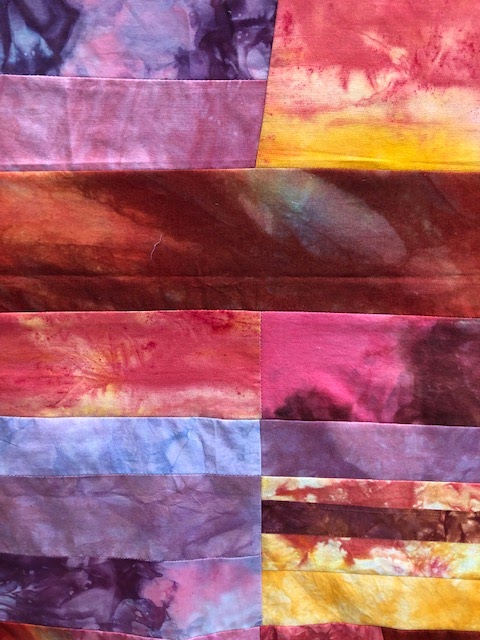I’d been collecting many of these vibrant fabrics from Dianne Johnston and other hand-dyers over many years. They had been collected for their sheer beauty. Some were destined to become part of a double bed quilt, envisaged by the images of outer space returning to us on Earth via satellite from millions of light years ago. I fancied sleeping under the stars in the comfort of my own bed! Grand, universal limitless space became transformed into the perhaps less grand, but regular events of our journey round sun, witnessed daily on our doorstep, sunrises and sunsets. And continuing the journey with such hand-dyed fabrics, they spoke to me of sunrises and sunsets, of dawn and dusk, the real experience of witnessing Earth’s journey around Sun - and all the metaphors and myths it has given rise to.
In my creative journey for designing this smaller quilt boundaries related to size were established. It was to fill a specific space on a wall in a bedroom. Every work of art has a purpose, concealing the artificial division between craft and what we call and revere as ‘the fine arts’. This time its purpose was to cover the unwanted sight of the frame of a small ‘dead’ air conditioner in the bedroom. The design is often limited by space. Space is what constrains – and necessarily designates design, spaces in which reside concept, skills and utility.

Cause and effect can be misplaced in the act of creation: we create in the process, the outcome often being as yet unseen, not yet eaten or worn, etc. I don’t have the creative gene in the same way that I have hazel eyes. The will to create has me in its grip. Creativity is definitely in the process rather than in the genes, rather than being 'talented' as is generally presumed. It’s about need, passion and will in equal share, and importantly, the opportunity to express them. Over many cycles of designing quilts, I have consciously tried to ignore the limitations of the well-known colour wheel with its normative suggestions of complementary colours. Fabric has its own limitations. Even though not showing commercial patterns, all fabric is fixed in colour and immutable, unlike a pallet of mixable paint colours. One of the pleasing aspects of hand-dyes is their streaky, blotchy nature, so that a deep red background can also reveal an orange and yellow splash, with a hint of blue. A marbled orange can hide hints of deep purple.
And of course it’s all about movement, the changing reflections of Earth’s surface on its daily travels in the annual migration round Sun.
It's trite to say that sunrises and sunsets are infinite, limited only by people's reactions. I started to collect images for inspiration from friends' photos on Facebook onto my computer. The truly spectacular and dramatic display of the setting sun can be breathtaking. From where I am situated on Earth, facing to the northeast, sunsets are less pronounced. But to watch the almost 180 degrees spread of the morning Sun’s incandescent glow arising in the darkness, emerging behind the bush surrounding the house, elicits immense awe and gratitude.

Other less conscious boundaries can occur through limitations placed on us by our perception – or the dis-ability to perceive differently. It took some time during the early stages to come to the understanding that my original plan was not only NOT going to work, but was unnecessary – coming from the way we usually see sunrises and sunsets: as horizontal; and distinct, and used to admiring the glorious colours of a summer sunset taking precedence over sunrises. As I was unravelling the relationship between sunrises and sunsets, I started to see the similarities in the time of day, at both the rising and setting of the sun. Instead of sunrise bands alternating with bands of sunset, I could see the colours in the fabrics merging into morning and evening horizons, each phenomenon becoming interchangeable. Oranges, yellows and blues are there on both occasions, at the start and end of the day, just as all shades of mauve and pink that streak the sky or light up floating clouds can be present in at both the beginning and ending of the day. The darker purples, ochres and grey-greens can recall the impending squall of a storm over the horizon, or the deepening descent of the night sky.
The fabrics started talking through the jangling clatter of my indecisiveness that had been rattling around in my head, I began to play by putting fabric strips beside each other, moving them to another strip, or returning them to their original place. Other ways of seeing became apparent. I started to listen to their suggestion that I had let go of the limitations I'd placed by trying to imitate or re-present and even sequence the beauty of Earth’s embrace of Sun. The fabrics were acknowledging not only their own limitations, but also other colour combinations that would work both horizontally and vertically for the composition, helping me to make the connections between these two magical cosmic phenomena. It was becoming clear that the quilt would be content to render an impression, rather than a distinct representation of sunrise and sunset, as I began learning to let the fabrics take the direction - instead of my ideas. More to come in next post.













